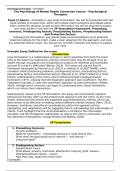Psychological Therapies - CLPS10001
The Psychology of Mental Health Conversion Course – Psychological
Therapies
Exam (2 hours) – Complete a case study formulation. You will be presented with two
client profiles to choose from, which will include client symptoms and details about
their current life situation as well as their life history. You will be required to assess
one client profile in line with the 5P formulation framework: Presenting
concerns, Predisposing factors, Precipitating factors, Perpetuating factors
and Protective factors.
Following the formulation, you should make recommendations as to potential
treatment options for the client, make a clear argument for the approach, and note
any potential ethical issues. You should use scientific research and theory to support
your case.
Example Essay Outline for the exam
Introduction
Case formulation is a collaborative process in which expertise from both the client
(who is the expert by experience) and the clinician (who may be thought of as an
expert through occupation) are recognised to produce an informed and accessible
account of a client’s difficulties (Bensa, 2016). This essay will use the Five Ps
framework developed by Macneil et al (2012) in relation to (CLIENT NAME), which
considers clients presenting problems, predisposing factors, precipitating factors,
perpetuating factors and protective factors. Macneil et al. (2012) called for a more
holistic understanding of the client, which embraced Engel’s biopsychosocial
framework (1977), arguing that the diagnostic approach was insufficient. The 5Ps
framework provides a ‘clear and systematic approach to case formulation’ (Peters,
2020), through which clinicians can begin to understand their clients holistically,
which can inform their intervention.
Subsequently, based on the 5P formulation, this essay will recommend cognitive
behavioural therapy (CBT) as the predominant approach with the client, as the most
widely researched and empirically supported psychotherapeutic method, which has
been shown to be effective in treating several different mental illnesses (Fenn, 2013).
However, limitations and ethical considerations within this approach will be
highlighted, and adaptations will be suggested which acknowledge the individuality of
clients. It will highlight that the recommendation is limited to the information
provided, and the therapeutic relationship, as well as the client’s motivation, are also
key elements of therapeutic change (Feixas and Botella, 2004).
5P Formulation
1. Presenting Concerns
- Current problems
- Need for treatment? – immediate because it could lead to this….
- Short term the goal would be to improve --- and reduce ---
- Long term goal?
2. Predisposing factors
- Genetic/brain injury
- Child abuse, poverty, hormonal, attachment, bullying, grief, trauma –
intergenerational trauma – racism
- How they may impact the client now?
Examples:
, Psychological Therapies - CLPS10001
Bullying
- Cook et al (2010) found victims of bullying often experience anxiety,
depression and low self-esteem and in extreme cases victims may kill
themselves.
Abuse – Child abuse can have long-lasting impacts on the child which, Collinshaw et al
(2007), have shown in their longitudinal study that child abuse is linked to high rates of
adult psychopathology (including depression, suicidal thoughts, and attempts).
Attachment - Attachment theory - developed by Bowlby (1969), looks at how a
child’s relationship with their primary caregiver or caregivers can affect their social
and emotional development.
- Shaver (2007) found attachment insecurity was common among people with a
wide variety of mental disorders e.g. depression, anxiety, eating disorders,
OCD, PTSD
Differential susceptibility to the environment
However, it is important to acknowledge that each child will be affected differently by different events in
their childhood, as the model of differential susceptibility to the environment (Boyce et al, 1995)
suggests. Therefore, it is important not to generalise (THE CLIENT’S) situation as their experience,
appraisal and the effects are individual to them.
3. Precipitating Factors
- Triggers that happen before the current problem e.g. life transitions, diagnosis,
break-up, death
- Some overlap triggers can be predisposing or precipitating
- Stress vulnerability model – different vulnerabilities
- Precipitating factors e.g. break up may trigger deep rooted belief about
oneself e.g. unlovable (owing to early childhood experiences)
- Loneliness/ social isolation – linked to depressive factors
In line with the diathesis-stress model – XXX may be an environmental stressor
which has interacted with (CLIENT NAME’S) inherent vulnerability to trigger the
symptoms (Broerman, 2017)
4. Perpetuating Factors
- Exacerbating factors that allow situation to continue for example: a lack of
social support, drugs, alcohol, toxic relationships, medication, social media
(this can be bidirectional)
5. Protective factors
- Acknowledge that therapy is not just about reducing distress but also
increasing strengths/positive values
- Can be dispositional factors or personal characteristics such as intellect,
tenacity, insight
- May also be factors like friends, family, hobbies
Protective factors move away from the problem areas that need interventions to
hope and optimism and look to future success and competence (Macneil et al.,
2012)
This is often the opportunity for the client to share what may help them move
forward, what their assets are, who can support them, and any other self-identified
skills (de Shazer, 1985).
Examples:




